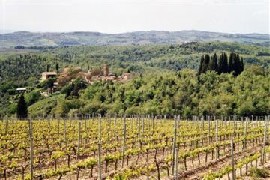 HISTORICAL NOTES
The name "Isole e Olena" was conceived in the 1950's when two adjoining estates, "Isole" and "Olena" were purchased by the De Marchi family and were combined to form one. The history of both estates dates back many hundreds of years, and the earliest documentation of the village of Olena as far back as the 12th Century. At that point in time many small villages sprung up in areas of Chianti which provided sufficient protection from outside invasion yet offered the possibility of cultivating adequate foodstuff to maintain the village population. As in the case of Olena, a typical village was perched on a vantage point from which one might survey the surrounding countryside. The houses in the village were small and grouped closely together around the church in the main square.
Isole was founded as an agricultural farm in the 1700's by the Elmi family who retained control of it until the present century. Isole is now the center of production for the Isole e Olena estate.
Beginning of the 1950's the De Marchi family began gradually phasing out the sharecropping system. New specialized vineyards were planted and the wine cellars were expanded. Today the Isole e Olena estate is run by Paolo De Marchi and his family. Paolo comes from a family with three generations of winemaking experience in the northern section of Piedmont. He was raised in close contact with the wine world as he has always enthusiastically followed the development of his grandfather's estate located near Gattinara, Villa Sperino, where Lessona wine is produced.
Paolo is well versed in the different wine regions of the world. He is a graduate of the Agriculture University of Turin (1976) with a specialization in Enology. As preparation for his thesis work he spent six months in California researching the evolution of the California wine industry. In 1980 he worked for the Istituto Sperimentale per L'Enologia di Asti. Today he maintains close contacts with the Enology Faculties of the Universities of Beaune, Montpellier, Turin, Geisenheim and California at Davis. Likewise, he continues to travel the wine regions of the world in an effort to foster an exchange of ideas, techniques and enthusiasm.
In 1976 Paolo began managing the estate wiht the goal in mind of combining his technical training with a willingness to experiment in order to firmly establish the winery as one of the forerunners in Chianti. At that time the cellars were modernized and experimental vineyard plots were planted.
The traditional 4-grape Chianti Classico blend was gradually altered to diminish the quantity of white grapes present until complete elimination. Thus the Isole e Olena Chianti evolved from being a light, young wine to the fuller-bodied wine of today which is destined for cellar aging. Simultaneously Paolo began experimenting with the production of a wine made exclusively of Sangiovese grapes. His efforts in this direction have yielded the resultant wine named Cepparello. In 1980 he produced the first Cepparello.
HISTORICAL NOTES
The name "Isole e Olena" was conceived in the 1950's when two adjoining estates, "Isole" and "Olena" were purchased by the De Marchi family and were combined to form one. The history of both estates dates back many hundreds of years, and the earliest documentation of the village of Olena as far back as the 12th Century. At that point in time many small villages sprung up in areas of Chianti which provided sufficient protection from outside invasion yet offered the possibility of cultivating adequate foodstuff to maintain the village population. As in the case of Olena, a typical village was perched on a vantage point from which one might survey the surrounding countryside. The houses in the village were small and grouped closely together around the church in the main square.
Isole was founded as an agricultural farm in the 1700's by the Elmi family who retained control of it until the present century. Isole is now the center of production for the Isole e Olena estate.
Beginning of the 1950's the De Marchi family began gradually phasing out the sharecropping system. New specialized vineyards were planted and the wine cellars were expanded. Today the Isole e Olena estate is run by Paolo De Marchi and his family. Paolo comes from a family with three generations of winemaking experience in the northern section of Piedmont. He was raised in close contact with the wine world as he has always enthusiastically followed the development of his grandfather's estate located near Gattinara, Villa Sperino, where Lessona wine is produced.
Paolo is well versed in the different wine regions of the world. He is a graduate of the Agriculture University of Turin (1976) with a specialization in Enology. As preparation for his thesis work he spent six months in California researching the evolution of the California wine industry. In 1980 he worked for the Istituto Sperimentale per L'Enologia di Asti. Today he maintains close contacts with the Enology Faculties of the Universities of Beaune, Montpellier, Turin, Geisenheim and California at Davis. Likewise, he continues to travel the wine regions of the world in an effort to foster an exchange of ideas, techniques and enthusiasm.
In 1976 Paolo began managing the estate wiht the goal in mind of combining his technical training with a willingness to experiment in order to firmly establish the winery as one of the forerunners in Chianti. At that time the cellars were modernized and experimental vineyard plots were planted.
The traditional 4-grape Chianti Classico blend was gradually altered to diminish the quantity of white grapes present until complete elimination. Thus the Isole e Olena Chianti evolved from being a light, young wine to the fuller-bodied wine of today which is destined for cellar aging. Simultaneously Paolo began experimenting with the production of a wine made exclusively of Sangiovese grapes. His efforts in this direction have yielded the resultant wine named Cepparello. In 1980 he produced the first Cepparello.